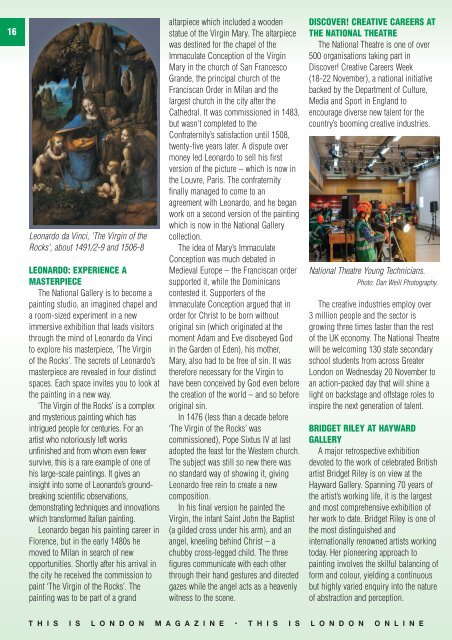This Is London - 8 November 2019
This Is London - 8th November 2019
This Is London - 8th November 2019
Create successful ePaper yourself
Turn your PDF publications into a flip-book with our unique Google optimized e-Paper software.
16<br />
Leonardo da Vinci, 'The Virgin of the<br />
Rocks', about 1491/2-9 and 1506-8<br />
LEONARDO: EXPERIENCE A<br />
MASTERPIECE<br />
The National Gallery is to become a<br />
painting studio, an imagined chapel and<br />
a room-sized experiment in a new<br />
immersive exhibition that leads visitors<br />
through the mind of Leonardo da Vinci<br />
to explore his masterpiece, ‘The Virgin<br />
of the Rocks’. The secrets of Leonardo’s<br />
masterpiece are revealed in four distinct<br />
spaces. Each space invites you to look at<br />
the painting in a new way.<br />
'The Virgin of the Rocks' is a complex<br />
and mysterious painting which has<br />
intrigued people for centuries. For an<br />
artist who notoriously left works<br />
unfinished and from whom even fewer<br />
survive, this is a rare example of one of<br />
his large-scale paintings. It gives an<br />
insight into some of Leonardo’s groundbreaking<br />
scientific observations,<br />
demonstrating techniques and innovations<br />
which transformed Italian painting.<br />
Leonardo began his painting career in<br />
Florence, but in the early 1480s he<br />
moved to Milan in search of new<br />
opportunities. Shortly after his arrival in<br />
the city he received the commission to<br />
paint ‘The Virgin of the Rocks’. The<br />
painting was to be part of a grand<br />
altarpiece which included a wooden<br />
statue of the Virgin Mary. The altarpiece<br />
was destined for the chapel of the<br />
Immaculate Conception of the Virgin<br />
Mary in the church of San Francesco<br />
Grande, the principal church of the<br />
Franciscan Order in Milan and the<br />
largest church in the city after the<br />
Cathedral. It was commissioned in 1483,<br />
but wasn't completed to the<br />
Confraternity’s satisfaction until 1508,<br />
twenty-five years later. A dispute over<br />
money led Leonardo to sell his first<br />
version of the picture – which is now in<br />
the Louvre, Paris. The confraternity<br />
finally managed to come to an<br />
agreement with Leonardo, and he began<br />
work on a second version of the painting<br />
which is now in the National Gallery<br />
collection.<br />
The idea of Mary’s Immaculate<br />
Conception was much debated in<br />
Medieval Europe – the Franciscan order<br />
supported it, while the Dominicans<br />
contested it. Supporters of the<br />
Immaculate Conception argued that in<br />
order for Christ to be born without<br />
original sin (which originated at the<br />
moment Adam and Eve disobeyed God<br />
in the Garden of Eden), his mother,<br />
Mary, also had to be free of sin. It was<br />
therefore necessary for the Virgin to<br />
have been conceived by God even before<br />
the creation of the world – and so before<br />
original sin.<br />
In 1476 (less than a decade before<br />
‘The Virgin of the Rocks’ was<br />
commissioned), Pope Sixtus IV at last<br />
adopted the feast for the Western church.<br />
The subject was still so new there was<br />
no standard way of showing it, giving<br />
Leonardo free rein to create a new<br />
composition.<br />
In his final version he painted the<br />
Virgin, the infant Saint John the Baptist<br />
(a gilded cross under his arm), and an<br />
angel, kneeling behind Christ – a<br />
chubby cross-legged child. The three<br />
figures communicate with each other<br />
through their hand gestures and directed<br />
gazes while the angel acts as a heavenly<br />
witness to the scene.<br />
DISCOVER! CREATIVE CAREERS AT<br />
THE NATIONAL THEATRE<br />
The National Theatre is one of over<br />
500 organisations taking part in<br />
Discover! Creative Careers Week<br />
(18-22 <strong>November</strong>), a national initiative<br />
backed by the Department of Culture,<br />
Media and Sport in England to<br />
encourage diverse new talent for the<br />
country’s booming creative industries.<br />
National Theatre Young Technicians.<br />
Photo: Dan Weill Photography.<br />
The creative industries employ over<br />
3 million people and the sector is<br />
growing three times faster than the rest<br />
of the UK economy. The National Theatre<br />
will be welcoming 130 state secondary<br />
school students from across Greater<br />
<strong>London</strong> on Wednesday 20 <strong>November</strong> to<br />
an action-packed day that will shine a<br />
light on backstage and offstage roles to<br />
inspire the next generation of talent.<br />
BRIDGET RILEY AT HAYWARD<br />
GALLERY<br />
A major retrospective exhibition<br />
devoted to the work of celebrated British<br />
artist Bridget Riley is on view at the<br />
Hayward Gallery. Spanning 70 years of<br />
the artist’s working life, it is the largest<br />
and most comprehensive exhibition of<br />
her work to date. Bridget Riley is one of<br />
the most distinguished and<br />
internationally renowned artists working<br />
today. Her pioneering approach to<br />
painting involves the skilful balancing of<br />
form and colour, yielding a continuous<br />
but highly varied enquiry into the nature<br />
of abstraction and perception.<br />
t h i s i s l o n d o n m a g a z i n e • t h i s i s l o n d o n o n l i n e

















